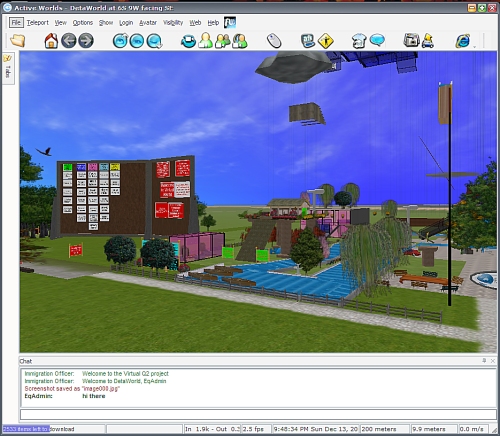Pre-Build
Asked for and was given [many thanks Lissa] “God” access to an Activeworlds project called Q2. Logging in I was presented with a plethora of structures, themed under “The Year of Creativity” which was 2009’s motto [who knew?] where a coordinator and a bunch of mentors let primary school students [years 5-7 I think] loose in a world, taught them to build and asked them to plan and construct around themes of “Fair, Healthy, Strong, Green and Smart”. The challenge posed was to envisage and represent in navigable 3D something that demonstrably connected with one of these themes. The real challenge was to connect back to something that would benefit the state.

Q2 Building Zone
The degree of sophistication that was achieved in builds varied, the intent and obvious enthusiasm did not. Kids really got into this constructionist and constructivist activity. On this level that interests me – having seem myself how passionate learners get when presented with open-ended tools and allowed to exercise their imagination. Given an overwhelming collection of objects to build from, and some basic construction advice, the metaview is impressive.
Kids being kids, extra, unrelated stuff was added [notes to each other, explosions, fast cars etc] but central ideas were strong. So long as this in-world activity was surrounded by sound pedagogy, had a design and collaboration phase and was not merely a meet and make session I see this as an incredibly rich adjunct to what must have been really powerful conversations in classrooms between teacher and student, student and student, student and mentor, teacher and mentor. the real power of a platform is that is facilitates transformation of information in to knowledge and wisdom.
How, then, is this different from giving them a box of LEGO and asking them to do the same activity?
Although that seems like a trivial question, it is seated in important discussion. If kids use pre-fabs to stick together things in 3D that represent concepts and ideas, how is it different to the real world activity – glue, cardboard and poster paint, plasticine, styrofoam and pasta pictures? If time is limited, and the build process complex, this can necessitate a “sameness” between constructions and this is neither good or bad, merely a product of the process – what can we do to value-ad this? What out-world scaffolding will make the in-world activities take on rich and valuable meaning to learners? Why will it bet better to do this in-world rather than out?
Do not get me wrong, I am not raining on anyone’s parade here, I am however mindful of the pedagogy, and conscious that when we make a place for kids to make things in, they will need skills to not merely use a “cookie cutter” approach as a solution, content – rich content – will need to be implicit and part of what they do, and the tools will need to make sense.
So, time to explore the building tools I think…